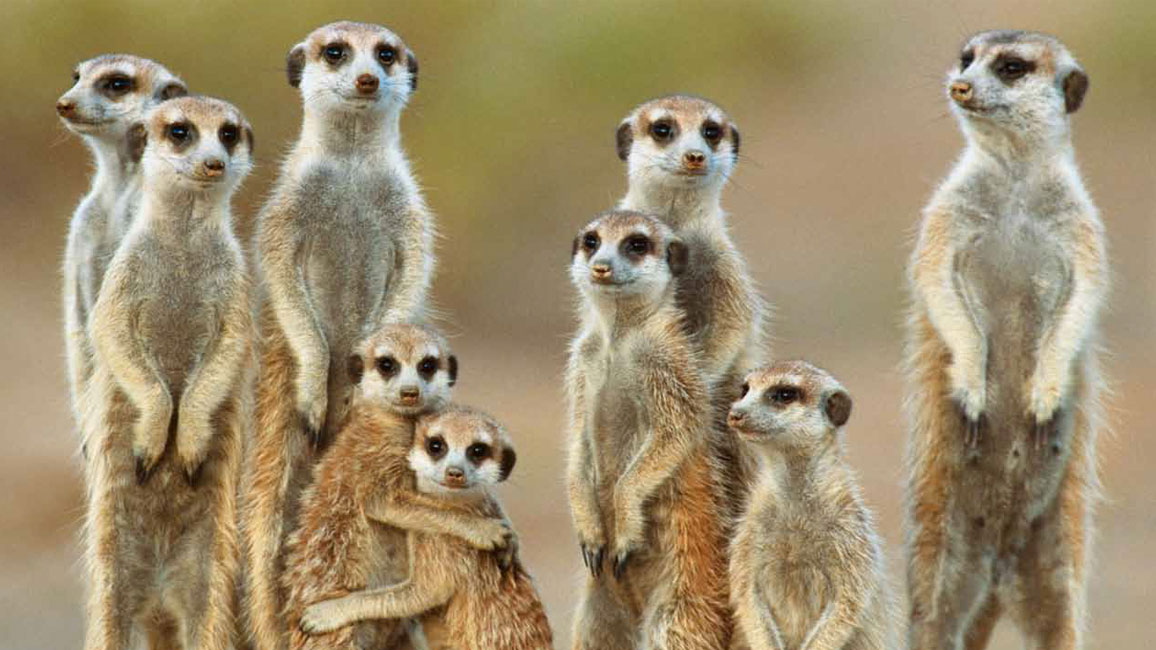
Meerkats
By Elizabeth Schleichert.Meerkats are totally into togetherness. Read on to discover their secrets for getting along with each other.
Meerkats are groupies, bigtime. As many as 40 individuals may live together. Among them may be Mom and Dad with their young pups, the pups’ older sisters and brothers, and many cousins!
Meerkats make getting along in a group seem easy. How do they do it? For starters, members of a group hang out together a lot. They sit back, relax, and often groom each other. Sometimes they tussle and play, too. This helps keep everyone happy and friendly! But meerkats have many more tricks for togetherness, as you’ll soon find out.
What’s a Meerkat?
- A meerkat is a squirrel sized mammal. It’s a kind of mongoose. Mongooses live mostly in Africa and southern Asia.
- Meerkats make their homes in burrows in the plains and deserts of southern Africa.
- A meerkat’s long, thin body is great for scooting through a burrow!
Sharing Jobs
As you know, a group gets along best when everyone pitches in and shares the chores. Meerkats are pros at this. For example, they take turns standing guard: keeping an eye out for danger so the others don’t have to worry about it. At the first sight of an eagle, hawk, or other predator, the guard barks or whistles loudly. That usually sends everyone racing for cover. When the guard gives an alarm call, the meerkats may dash into a wide tunnel called a “bolt hole.”
From a high mound, a guard keeps a sharp eye out for danger. Thanks to the guard, the other members of the group can safely go about their business. When looking for lunch, for instance, almost the whole gang sets off together, taking a slightly different route each day. That increases their chances of finding food. As they go, the meerkats sniff the ground for underground prey. Their favorites? Juicy, wormlike beetle grubs and scorpions. Once a meerkat picks up the scent of a buried meal, it starts digging. Its sharp front claws get at the food in no time. During a morning of hunting — and digging — a single meerkat may leave behind hundreds of holes, empty of their former residents!
Sharing and Caring
By far the most incredible example of meerkat teamwork is childcare! Nearly everyone in the group, both male and female, takes turns babysitting the group’s young pups. And Mom? She nurses her pups, but otherwise she’s not around much. She heads off with the rest of the adults to find food. She needs to keep eating so she can produce enough milk for her babies.
Training the Pups
The babysitter has to be especially cautious when the eager pups are ready to explore the world outside of the familiar burrow. After all, danger could strike at any time — and the pups would hardly notice. They’re too busy playing and wrestling with each other. Meerkat pups spend much of their day playing.
Finally, when they’re about a month old, these mischievous little meerkats will be big enough to tag along with the rest of the group. But they still won’t have learned all the tricks to catching their own food. So the ever-patient adults in the crowd will share their meals—and some will take time to teach the little ones how to hunt and grab prey. It won’t be long before the pups catch on to this—and to all the other secrets of living in one big, happy group, too.
“Meerkats” originally appeared in the june/july 2010 issue of Ranger Rick magazine.
(Click on each image above for a closer view of the story.)



















